BlackBerry Porsche Design P’9981 Review
BlackBerry Porsche Design P’9981
The perfect accompaniment to your Porsche car or an overpriced folly? We found out.
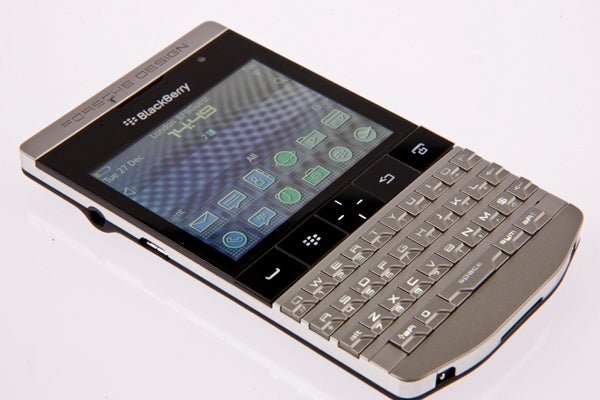
Verdict
Pros
- Genuinely standout design
- Very well built
- Superb keyboard
Cons
- Trails the competition on almost all technical fronts
- BlackBerry OS 7.0 is nice but limited
- App selection not good enough
- Is ultimately way overpriced
Key Specifications
- Review Price: £1275.00
- Leather back and Steel chassis
- 1.2GHz single core processor
- 5 megapixel camera
- Adapters for all plug types included
- Stylish charging dock included
Designer phones seldom live up to expectations, as they tend to be expensive simply for the sake of it. Buy a Porsche 911 or a Rolls Royce and you not only get a car that’s beautifully made, you get better performance and better features than your average motor. Not so with posh phones, though. They tend to offer only as much, and often less, than the best ‘normal’ phones with only a bit of bling to make up for the extra cost.
So, can the BlackBerry P’9981 crafted by Porsche Design break this trend?

Well, dealing with that all important design first, the P’9981 (or P9981 if you like) certainly ticks most of the right boxes. Tough steel and glass dominate the front while the back is covered in soft black leather. The design is perhaps a bit utilitarian and lacking in true bling but it’s also classy, and clearly a cut above.
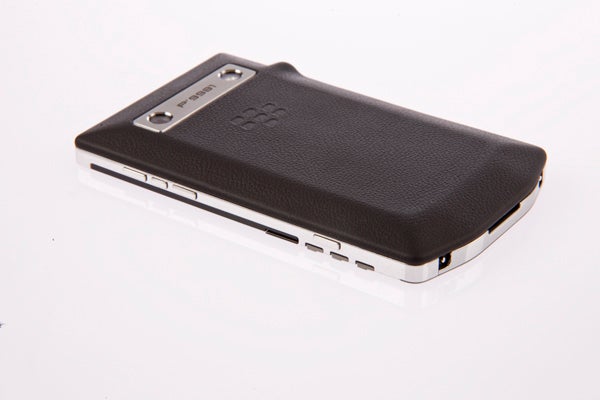
The fit and finish is also better than most. The sand blasted steel feels great while touches like the etched Porsche Design logo above the screen and ‘P’9981’ on the back, are perfectly executed. There’s not a hint of flex or give to the body, despite a removable backplate (we had no issues with the backplate coming loose as others have reported), and all told you feel like you’re gripping something that rightly costs that bit more.
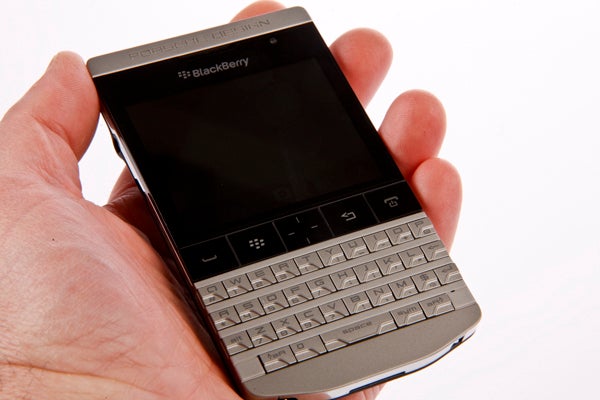
It’s a bit heavier than the Bold 9900 on which its based, with a weight of 155g compared to 130g, and it’s a little larger too with dimensions of 115 x 66 x 10.5 mm vs 115 x 67 x 11.3 mm but it’s actually an easy device to handle thanks to that leather finish giving a firm comfortable grip and the buttons and controls being well placed. In particular the screen lock button on the top edge and the full expanse of the screen are both easy to reach, as are all the navigation buttons and keyboard. The volume keys on the right edge also fall easily under finger or thumb, along with the play/pause button that sits between them. The only issue is that they’re a bit small, so aren’t that easy to press with the phone still in your pocket.
There is one potentially major slip up, though. Each of the navigation buttons is a little square of glass that looks pretty snazzy. But, as well as having a slight wobble that large buttons of that type often have, they’re also prone to being damaged. You see, both these buttons and the keyboard buttons run right to the edge of the phone where they’re susceptible to being knocked. This had clearly already happened to our review sample before it arrived to us as the power button (the right most one) sits slightly awkwardly and can easily be prised up further than it should.
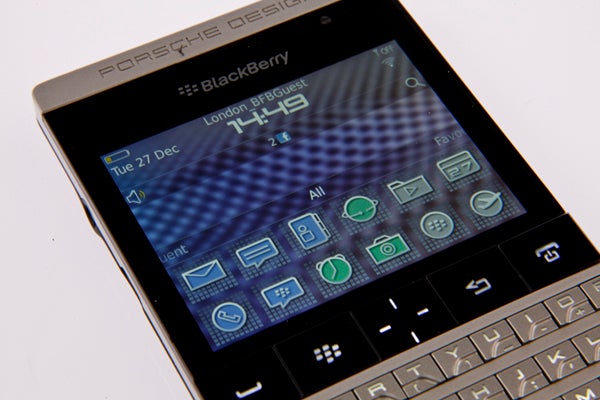
The screen, also, has a bit less visual pizzazz than we’d hope for. It’s kind-of understandable that the display is no bigger than that of the Bold 9900 but given the extra cost and extra girth of this phone, a bigger, bolder display would’ve been nice. As it is you get a 2.8in LCD panel with a resolution of 640 x 480 pixels. This is a high pixel count for a screen this size but it’s still not exactly iPhone-rivalling.
It’s of reasonable overall quality with punchy colours, good viewing angles and good contrast but it just doesn’t excite in anyway. At least the touch element of it is responsive and easy to use.
The BlackBerry Porsche Design P’9981’s keyboard is a surprise success. We were sceptical of its overly styled design, angular keys and straight rows of keys (rather than the curved rows of the 9900) but actually it has proved to be excellent. The sharp angles cut into each key provide excellent purchase, the layout is good and the extra width of the phone (plus the fact the keys go right to the edge) means each key is that bit larger and thus easier to hit. All told, we actually think it’s one of the best phone keyboards we’ve ever used. The only real issue, aside from us not liking the standard BlackBerry location of the number keys, is the subtle key markings mean you sometimes have to search around for a while to find the symbol you’re looking for – this is much less of an issue in dark conditions when the backlight kicks in though.
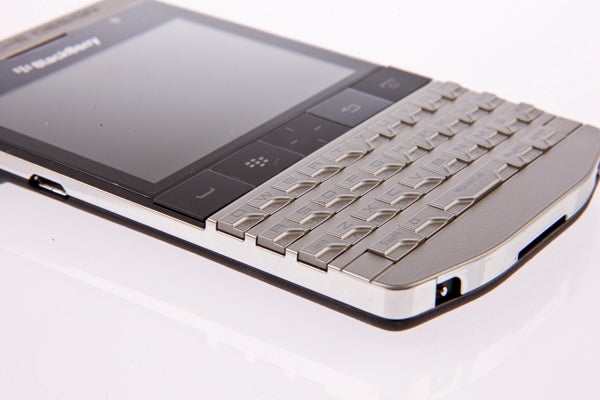
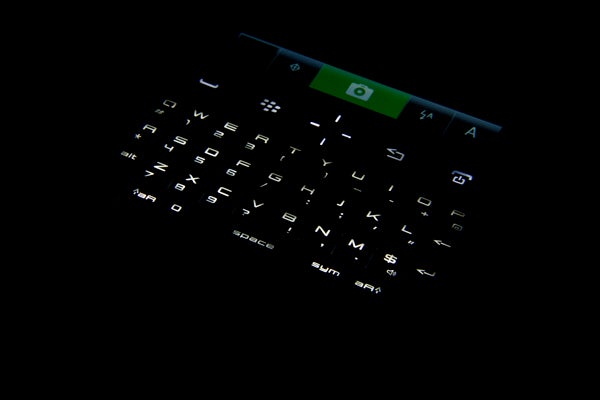
Finishing up looking at the external features, on the back is a 5-megapixel camera with its LED flash (there’s no forward facing camera). It’s a decent enough snapper in terms of its raw image quality but it lacks extra features like the ability to tap anywhere on the screen to pick your focal point, and both in-shot and post-shot processing/editing are very limited; there’s a selection of scene modes and the ability to rotate your images once taken, but that’s about it, without resorting to 3rd-party apps.
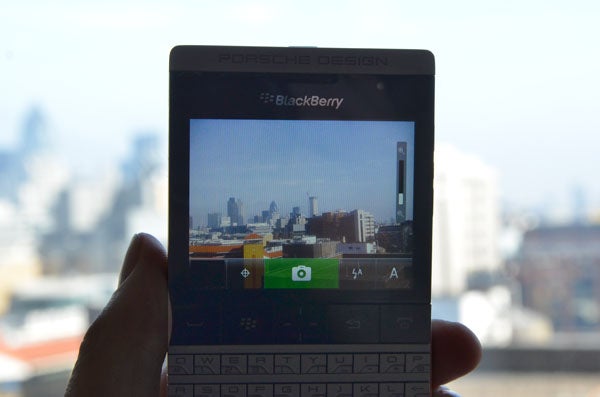
Video can be recorded in up to 720p HD Ready resolution and again the overall results are perfectly okay but there’s nothing to set this phone apart from the crowd.
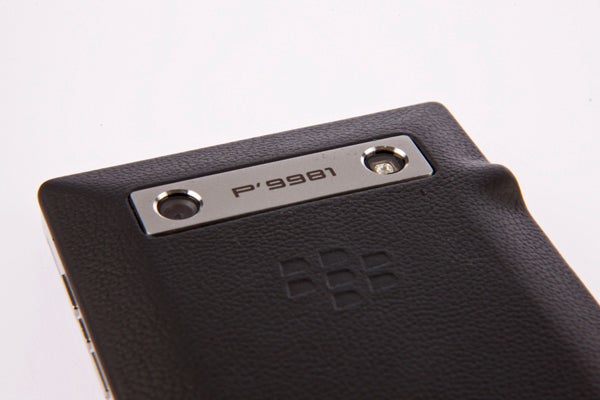
On the left edge of the phone there’s a headphone jack and microUSB socket. We’re still perplexed at BlackBerry’s insistence on putting the headphone jack on the side, as it’s immensely annoying for when putting your phone in a pocket with headphones attached. At least it’s consistent for those regular BlackBerry users, we suppose.
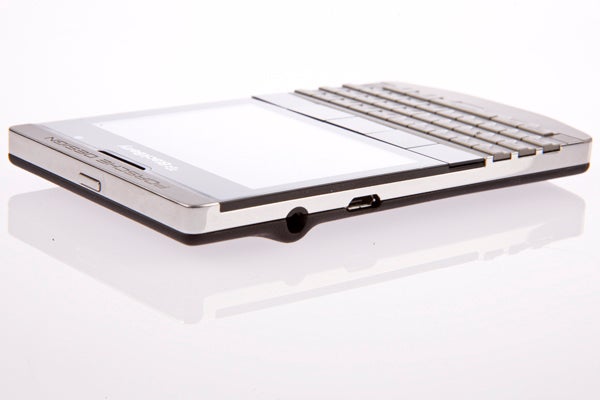
More to our liking are the two charging points on the bottom edge of the phone. These marry up with the contacts on the included charging dock. Also faced in steel, it’s a simple but stylish dock that will hold the phone at a comfortable viewing angle while charging, and when docked the phone shows an analogue clock display which is a nice touch.
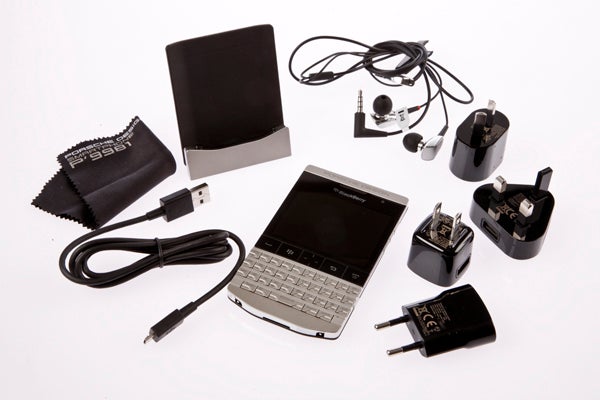
Included in the box are tiny separate chargers for UK, US, European and Asian plugs, meaning you can just grab whichever one you need for wherever it is you’re going. They’re just normal USB chargers too, so can be used with all your other mobile devices, as long as you have the cable. Arguably a universal charger with interchangeable plugs would’ve been even better but this is certainly a better showing than most handsets.
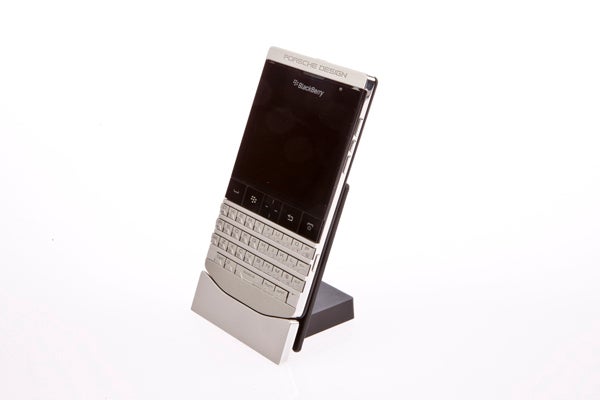
Less impressive is the included headset. It’s stylish enough and includes three different sizes of rubber tips for the ear pieces, giving you a choice of fit (they isolate you from outside noise quite well actually), but the earpieces feel plasticky and they deliver fairly weedy audio. A step up from the most basic bundled sets perhaps, but – let’s just say – they alone certainly don’t make up for this phone’s high price. At least they incorporate a remote for taking calls and controlling your music into the cable.
Finishing off the physical features, under the backplate is a microSD slot, along with a 1,230mAh battery and the SIM slot. The microSD slot lets you add up to an extra 32GB of storage to the 8GB already built into the handset, which is a better storage complement than the majority of handsets. Not only that but you don’t even have to remove the battery to take out the microSD card. A small but welcome touch.
Beneath its premium exterior, the BlackBerry Porsche Design P’9981 is just a Bold 9900, so its performance is exactly the same, which is both a good and a bad thing. Good because at least you’re not losing anything compared to the standard model – as mentioned earlier this isn’t a given on designer phones – but bad because the Bold 9900 isn’t all that cutting edge a handset.
Most high-end smartphones now pack dual-core processors, with quad-core handsets expected to be announced in only a couple of weeks time. In contrast the P’9981 has only a single core processor (Qualcomm MSM8655). It does run at a fairly sprightly 1.2GHz but then so do most of the dual-core phones.
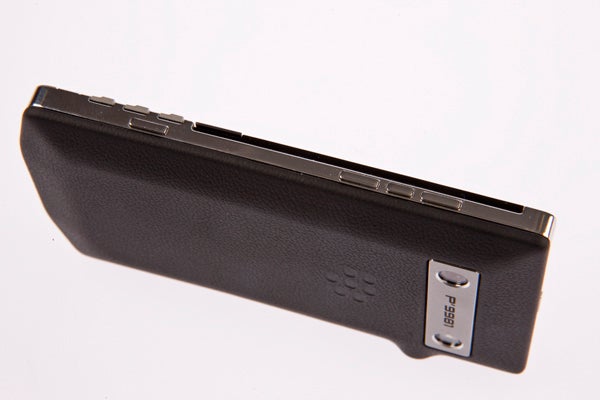
What does this mean for performance? Well, in most situations, not all that much. While tapping out a tome, flicking through Facebook or perusing your pictures you won’t notice any issues. The interface feels snappy and animations are smooth as you move around. However, start flicking between apps at a pace and things slow up a little. The web browser can also get a bit sluggish with graphically rich websites. Moreover, there’s simply the fact that there’s less performance head room for apps to take advantage of in the future.
This would be more forgivable were the phone’s interface more capable. We’ve mentioned the limited extras available in the camera app already but the same could be said of much of the BlackBerry OS 7.0 interface.
You get a very capable web browser, excellent email client, sophisticated contacts management, easy to use picture and video viewers, a smart calendar app, a functional Facebook client, and much more besides. However, on almost every front, it’s either only as good as or worse than the competition.
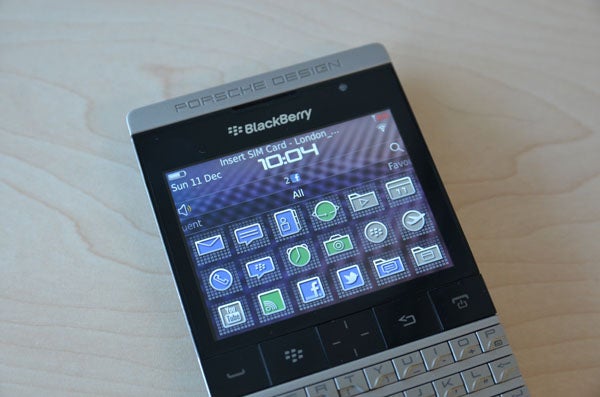
Take contacts, for instance. You can have them push and pull information (including photos) from your Facebook account but that’s about as far as social network integration goes. Open a contact and you can’t see a stream of your interactions with that person, as you can on many Android and Windows Phone smartphones. In this regard, the P’9981 is actually better than the iPhone 4S, with that phone having no social network integration at all.
Another example is the web browser. Here the P’9981 is actually on a par with the iPhone in terms of raw capabilities, with a slick interface but no support for Flash videos or any other notable extras – Android devices again have it beat, though.
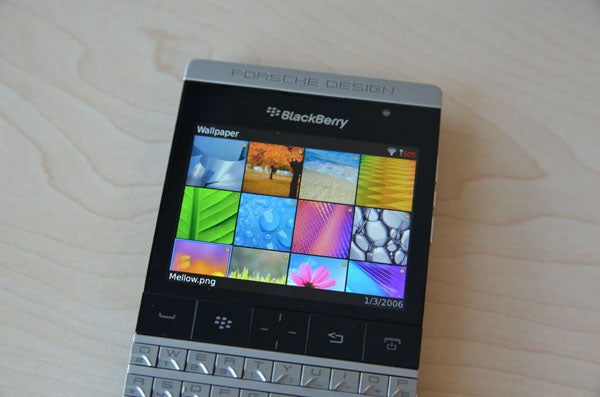
You of course get the BlackBerry extras like BlackBerry Messenger and the unique BlackBerry email service with its generally world beating reliability and speed, but frankly these messaging services are starting to lose there lustre in the face of growing competition. If you’re locked into the BlackBerry way, you’ll appreciate a new handset to add to the roster but for newcomers there’s dwindling reason to go the BlackBerry route when it comes to messaging.
BlackBerry has given the Porsche Design P’9981 a unique interface that mirrors the stark angular external design. It’s quite a nice look that certainly sets it apart but there are two rather key issues. The first is that the restyled icons are even more difficult to decipher than the standard BlackBerry ones and the second is that any new apps added to the device don’t match the style. If you just want to forgo the whole thing, you can turn it off.
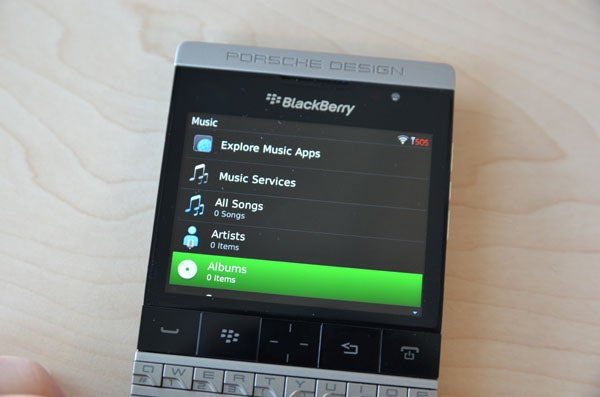
Apps are the final death knell for this phone. The list of apps in the BlackBerry App World is growing but it’s still at least an order of magnitude behind the ~600,000 available for iPhone. Moreover, the selection doesn’t include many stalwarts of other devices.
As ever with BlackBerrys, the P9881 is excellent for making calls, with a loud earpiece and speaker and good call quality delivered from the noise cancelling microphone. Then again, few top end handsets trip up here nowadays. Battery life meanwhile is only average at around a day and a half in normal use – standby life is very good, though.
”’Verdict”’
The BlackBerry Porsche Design P’9881 is clearly an overpriced fashion handset that does little to truly justify its £1275 price. However, there is a charm to its build and styling that does make it stand out from the crowd. Moreover, the keyboard is superb and there are some nice extras included in the box. Ultimately, though, it’s the BlackBerry part of the partnership that lets it down. While BlackBerry OS 7.0 is a vast improvement over previous iterations, it still trails much of the competition for both core features and availability of apps. An almost justifiable indulgence for BlackBerry users but a far from sensible purchase for the rest of us.
How we test phones
We test every mobile phone we review thoroughly. We use industry standard tests to compare features properly and we use the phone as our main device over the review period. We’ll always tell you what we find and we never, ever, accept money to review a product.
Trusted Score
Score in detail
-
Performance 6
-
Camera 7
-
Design 9
-
Usability 7
-
Value 2
-
Features 7
-
Screen Quality 6

